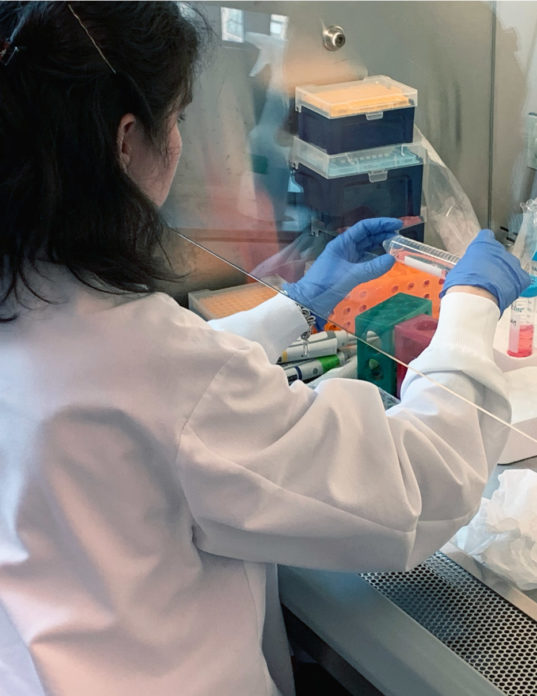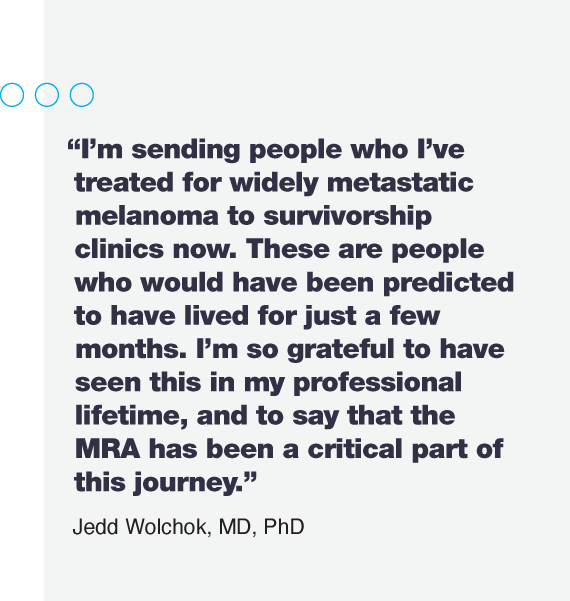Reflecting on a Decade of Progress and Future Heights

If you told Dr. Jedd Wolchok at the start of his oncology career what melanoma research would look like today, he likely wouldn’t believe you.
Wolchok, now a world-renowned medical oncologist and Meyer Director of the Sandra and Edward Meyer Cancer Center at Weill Cornell Medicine, originally faced an alternate reality from where we find ourselves today.
When Wolchok began his career in oncology around the year 2000, the treatment options for and enthusiasm about melanoma research were slim:
So why would a promising young doctor want to specialize in such a field? Many shied away from melanoma at pivotal points in their training and careers; Wolchok himself was actively discouraged from specializing in the field. As Wolchok explains: “It was a hard slog uphill because there was not a lot of enthusiasm.”
But Wolchok and a small group of oncologists persevered. “There were some of us who were elbow-deep in the science and had our ear to the ground about where the basic science was leading in terms of new pathways that controlled immune regulation,” says Wolchok. Where others saw failure, Wolchok saw potential. Yet the path forward was anything but clear.

If you told Dr. Jedd Wolchok at the start of his oncology career what melanoma research would look like today, he likely wouldn’t believe you.
Wolchok, now a world-renowned medical oncologist and Meyer Director of the Sandra and Edward Meyer Cancer Center at Weill Cornell Medicine, originally faced an alternate reality from where we find ourselves today.
When Wolchok began his career in oncology around the year 2000, the treatment options for and enthusiasm about melanoma research were slim:
So why would a promising young doctor want to specialize in such a field? Many shied away from melanoma at pivotal points in their training and careers; Wolchok himself was actively discouraged from specializing in the field. As Wolchok explains: “It was a hard slog uphill because there was not a lot of enthusiasm.”
But Wolchok and a small group of oncologists persevered. “There were some of us who were elbow-deep in the science and had our ear to the ground about where the basic science was leading in terms of new pathways that controlled immune regulation,” says Wolchok. Where others saw failure, Wolchok saw potential. Yet the path forward was anything but clear.
A few years later, an immunologist by the name of James P. Allison, PhD, was recruited to Memorial Sloan Kettering, where Wolchok worked at the time. Allison, now a Nobel laureate, was studying the CTLA-4 immune checkpoint pathway and discovered the medication now known as Yervoy (ipilimumab).
Wolchok volunteered to be a principal investigator in the medication’s early clinical trials—and by 2010, a watershed moment arrived: the ipilimumab phase 3 trial demonstrated the first-ever statistically significant survival benefit for people with metastatic melanoma.
The breakthrough caught the attention of the scientific community, and its excitement was felt far and wide:
It was nothing short of a sea change.
For Wolchok, progress was personal: “The most palpable change for me was my waiting room. It used to be that when you treated a disease that had a 6.5-month median survival, your waiting room wasn’t necessarily full of familiar faces. Now, many of my patients recognize each other and see each other over years. It’s a visible and welcome difference.”
Wolchok adds, “I’m sending people who I’ve treated for widely metastatic melanoma to survivorship clinics now. These are people who would have been predicted by whatever textbooks to have lived for just a few months. I’m so grateful to have seen this in my professional lifetime, and to say that the MRA has been a critical part of this journey.”


From L to R: Jeff Rowbottom, Ian Schuman, Kerry Murphy Healey, Fran Rowbottom, Michael Milken, Charlotte Ariyan, MD, PhD, and Jedd Wolchok, MD, PhD
A few years later, an immunologist by the name of James P. Allison, PhD, was recruited to Memorial Sloan Kettering, where Wolchok worked at the time. Allison, now a Nobel laureate, was studying the CTLA-4 immune checkpoint pathway and discovered the medication now known as Yervoy (ipilimumab).
Wolchok volunteered to be a principal investigator in the medication’s early clinical trials—and by 2010, a watershed moment arrived: the ipilimumab phase 3 trial demonstrated the first-ever statistically significant survival benefit for people with metastatic melanoma.
The breakthrough caught the attention of the scientific community, and its excitement was felt far and wide:
It was nothing short of a sea change.
For Wolchok, progress was personal: “The most palpable change for me was my waiting room. It used to be that when you treated a disease that had a 6.5-month median survival, your waiting room wasn’t necessarily full of familiar faces. Now, many of my patients recognize each other and see each other over years. It’s a visible and welcome difference.”
Wolchok adds, “I’m sending people who I’ve treated for widely metastatic melanoma to survivorship clinics now. These are people who would have been predicted by whatever textbooks to have lived for just a few months. I’m so grateful to have seen this in my professional lifetime, and to say that the MRA has been a critical part of this journey.”


From L to R: Jeff Rowbottom, Ian Schuman, Kerry Murphy Healey, Fran Rowbottom, Michael Milken, Charlotte Ariyan, MD, PhD, and Jedd Wolchok, MD, PhD
And, indeed, what a journey it has been. Perhaps some of the most surprising breakthroughs include:
“What tops everything is the joy and hope that gains in research have given melanoma patients,” says Wolchok. “All of these moments that people never imagined that they would live to see. Things like, ‘I never thought I would see my kids go to college,’ or ‘I never thought I would see grandchildren.’ This has been an amazing accomplishment.”
The field is light years from where it started. But not all progress has been equal. Better therapies are still needed for rare melanomas, such as acral, mucosal, and uveal. In addition, some melanomas are resistant — or develop resistance — to even the latest therapies. These are what Wolchok calls therapeutic challenges, but he cautions that there are also big-picture issues that require attention as well.
There are many unanswered questions, for example: “We don’t know how long to treat people with checkpoint blockade,” says Wolchok. “Most of these medicines are approved without an end date. From a patient safety and societal healthcare utilization viewpoint, we have a responsibility to tighten that up. If someone has a good response to treatment, maybe we should just stop. Maybe there’s no need to keep pounding away with the possibility of creating a toxicity in someone who’s already cured.” The PET-Stop clinical trial is currently seeking to answer this question by examining the safe discontinuation of anti- PD-1 immunotherapy after one year of a normal PET scan.
Wolchok says another area of ongoing research is adjuvant therapy (i.e., therapy after surgery). Although therapy can help prevent a recurrence, recurrence isn’t a certainty. “That’s one of my biggest fears,” says Wolchok, “that we end up treating someone that’s already cured, creating toxicity, and then unintentionally causing more harm than good. We have an obligation to try and come up with ways to distinguish people who have no evidence of disease from those who may have minimal residual disease. These are important topics…and when it comes to our new therapeutic tools, we need to understand how much is enough.”
Despite remaining obstacles, however, Wolchok believes now is a time of immense hope: Hope for patients, hope for the field, and hope for the future.
It’s a future that has been dramatically changed thanks to the Melanoma Research Alliance (MRA). Wolchok says, “MRA minimizes the burden on the investigator: Short applications, almost immediate funding for meritoriously reviewed applications, not a lot of onerous paperwork—just getting the job done.” Wolchok believes that research can control cancer, meaning that when there is enough funding for research and researcher obstacles are mitigated, the real magic can finally occur. And this is exactly what MRA seeks to do.
Moreover, MRA regularly engages a wide variety of thought leaders from bench to bedside when setting research and funding priorities. “MRA looks to the boots on the ground and from the people in the field and asks: ‘What do you think are the most important areas of focus for this year’s request for proposals?’” says Wolchok. This engagement is a reflection of MRA’s commitment to championing real collaboration and acceleration in the field. ![]()
1. Hodi FS, O’Day SJ, McDermott DF, et al. Improved Survival with Ipilimumab in Patients with Metastatic Melanoma. N Engl J Med 2010; 363: 711-23. Available at: www.nejm.org/doi/full/10.1056/nejmoa1003466